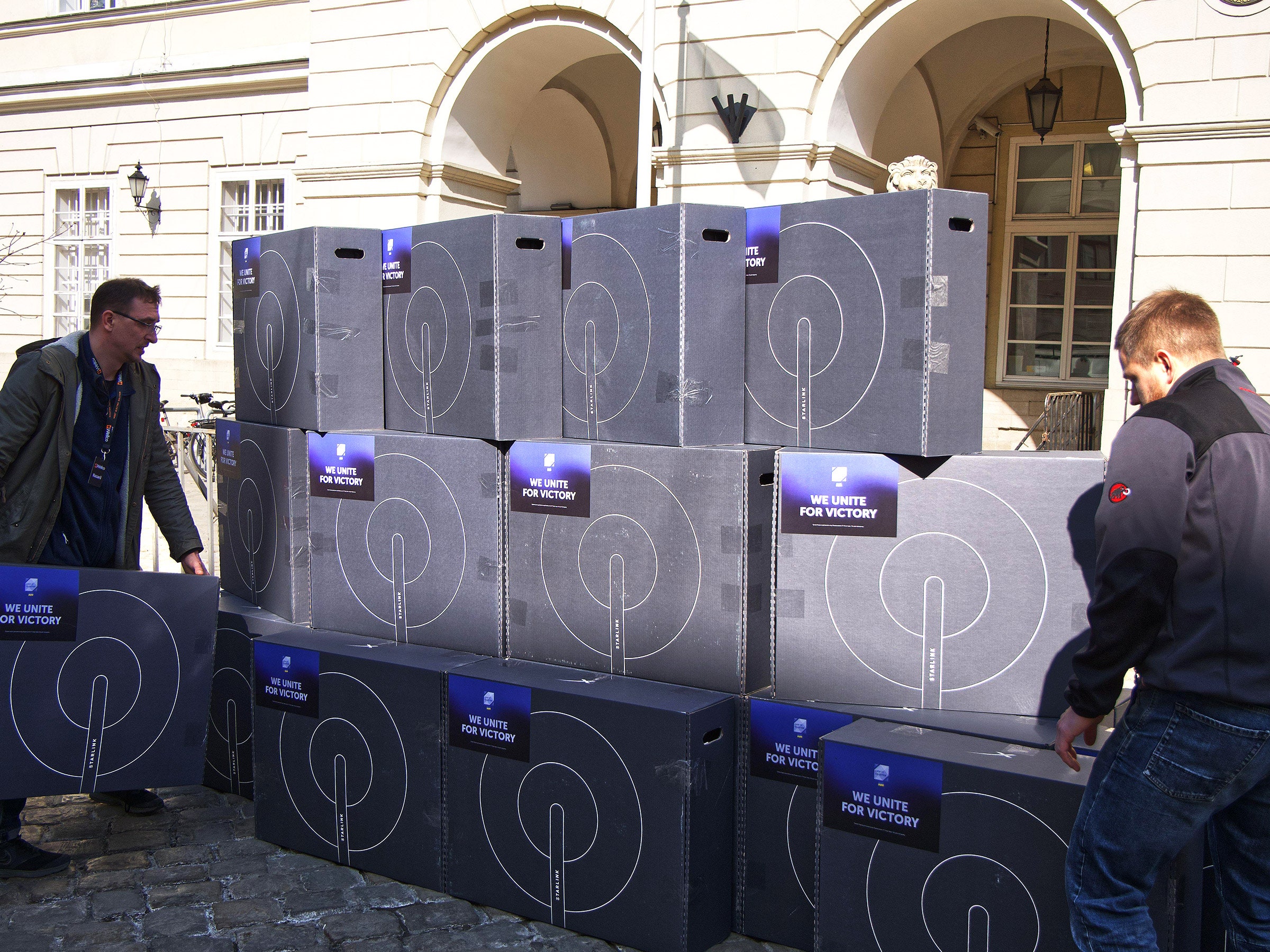
Two days after Russia invaded, Fedorov tweeted a request for Starlink terminals at Musk. Ten hours later, the SpaceX CEO confirmed that Starlink’s service was “active” in Ukraine. Just two days later, on February 28, Fedorov posted photos of a truck stacked high with Starlink boxes, and himself unboxing a Dishy.
Behind the scenes, SpaceX scrambled to upgrade its service for use on a battlefield. A firmware update enabled terminals to be powered by a car’s cigarette lighter. The company also had to adapt to Russian attempts to interfere with signals between terminals and satellites. Dave Tremper, a director of electronic warfare at the Pentagon, praised the speed with which SpaceX evaded that jamming with a software update. “How they did that was eye-watering to me,” he said at a conference on defense technology, lamenting that US military equipment was not so flexible. “We need to be able to have that agility.”
Starlink’s work in Ukraine also got a boost from the US government. The US Agency for International Development began talking with SpaceX about supporting distribution of its terminals in early March, says agency spokesperson Ashley Yehl. USAID paid to move a shipment of 5,000 terminals to Poland and worked with Ukraine’s government to arrange their final hop across the border. The US government paid for 1,333 of the terminals, with SpaceX picking up the bill for the rest.
The agency disclosed the project in early April, releasing a statement that explained the terminals would allow officials and citizens to communicate with each other and the world “even if Putin’s brutal aggression severs Ukraine’s fiber-optic or cellular communication infrastructure.”
By late April, there were more than 10,000 Starlink terminals in Ukraine, Fedorov said in a Telegram post. On May 2, he tweeted that around 150,000 Ukrainians use the service each day. The technique used to bring Irpin back online is now standard protocol for territory liberated by Ukrainian forces. Nokia has also updated software used on its equipment for cell towers to better support Starlink, Naumenko of Vodafone says.
In the Chernihiv region northeast of Kyiv, fighting destroyed 10 kilometers of cable, knocking a string of villages with about 400 internet subscribers offline, Fedorov says. The local ISP was able to bring them all back online with a single Starlink.
Starlink also reconnected the town of Borodyanka, which was liberated three days after Irpin on April 1. Early the next morning, workers from Ukrainian telco Kyivstar brought in a movable mobile base station with a Starlink receiver attached. Kyivstar has now deployed that solution several times, says chief technology officer Volodymyr Lutchenko. A cell tower connected via Starlink can’t operate at the speed of one linked via optical fiber, but it can still support the calls and mobile data people need to get back online, Lutchenko says.
How Starlink terminals have helped Ukraine’s military is less clear. When asked what proportion of the devices are used by the country’s armed forces, Fedorov replied, through an interpreter, that “most of them are used for civilian purposes.” Those include reconnecting hospitals, ISPs, and some tech companies that have foreign customers.
Other sources depict Starlink terminals functioning as a powerful tool of Ukraine’s military. In March, The Times of London reported that Ukrainian forces used reconnaissance drones linked to Starlink terminals to send targeting information to artillery. In April, The New York Times posted a video of a member of Ukraine’s National Guard saying he was among those trapped under steelworks in Mariupol by Russia’s siege of the city, but was still online thanks to Starlink.
Last week a Twitter account in the name of James Vazquez, who claims to be a US veteran now helping Ukraine’s military, posted a video thanking Musk for Starlink. “It came in very handy today, saved a lot of our asses,” he said, gesturing at a Dishy painted military green and mounted on top of a van. Vazquez did not respond to a request for comment, but his status as someone currently at work in Ukraine has been vouched for by Republican US representative Adam Kinzinger.
Starlink’s success in Ukraine suggests it and other new-generation satellite services could be a powerful tool in conflicts and disasters in other parts of the world, or a way to help people living in places with overbearing internet controls, says Michael Schwille, who works on information warfare policy at the Rand Corporation.
The US government has a long history of supporting technology that can get unfiltered or important information to people seen to need it, Schwille argues, including Radio Free Europe and grants that funded anonymity service Tor and encryption app Signal. “USAID has been in the democracy promotion business for a long time,” he adds. “I’m sure they are thinking about where else this kind of technology could be used.”
Recent events in Kherson, a Russian-occupied city in Southern Ukraine, underline the potential of Starlink to punch through internet restrictions. Ukrainian officials told the Financial Times last week that a fiber-optic cable previously used by Ukrainian ISPs had been rerouted to a Russia-linked provider in occupied Crimea. That could lock residents inside the Kremlin’s increasingly aggressive system of online censorship.
SpaceX’s coverage map shows Kherson firmly inside its service area in Ukraine, suggesting Starlink terminals there could provide an uncensored alternative. Dmitry Rogozin, the head of Russia’s space agency, has repeatedly criticized SpaceX and Musk in recent months, and previously alleged that Starlink functions like an arm of the Pentagon, not a commercial service.
Ukraine has been an eye-opening test case for Starlink—but using of satellite internet as a tool of liberation in other parts of the world would likely be more complex. Ukraine invited Starlink to use its airwaves but many countries won’t. Croshier from the Center for Global Development doesn’t expect to see Starlink provided in Ethiopia, for example, where people have suffered internet shutdowns as a result of civil war. “It’s a more complex situation that is not directly in the US interest,” she says. Nor would it be simple for Musk to provide Starlink access to China, where his automaker, Tesla, has a factory that might be targeted in retaliation, Croshier says.
Those complexities don’t appear to have convinced Russia or China that they have nothing to fear from Starlink. Officials from both countries have criticized the company’s actions in Ukraine. And the two countries also have plans for their own internet satellite constellations—which will almost certainly be firmly under government control.
Lire l’article complet sur : www.wired.com







Leave A Comment